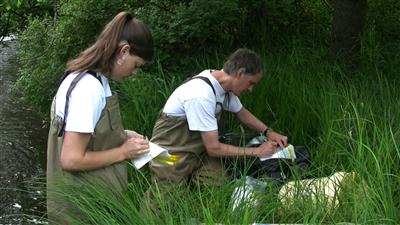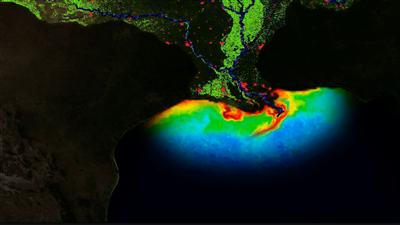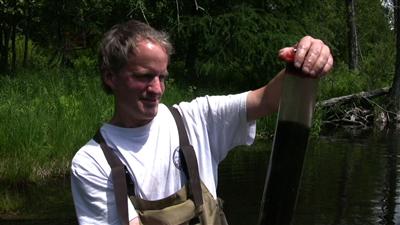
Credit: UW Sea Grant
May 27, 2011
By Carolyn Rumery Betz
The Green Revolution-not the kind that celebrates Earth Day, solar panels and recycling but the one related to food production-has used various technologies to meet the world’s nutritional needs by growing more food per acre. The amount of nitrogen present in the soil is one of the main factors that controls plant growth, and farmers add nitrogen fertilizer, often in the form of anhydrous ammonia, to maximize yields. However, adding more fertilizer than crops need to grow results in surface and groundwater contamination.
In a research project funded by the Water Resources Institute, Bob Stelzer, associate professor of biology at UW-Oshkosh, is examining the ability of bacteria in sediments at the bottom of streams to convert nitrates, a form available to plants, into atmospheric nitrogen, which is not an aquatic pollutant.
Worldwide, there is more available nitrogen in our environment than ever before because of fertilizers and burning of fossil fuels, according to Stelzer.
Too much nitrogen in our lakes and streams can lead to excessive plant growth, degraded recreational experiences, and fish kills. The cumulative effects of excess nitrogen moving downstream from the Corn Belt have created a “dead zone” in the Gulf of Mexico.

Credit: National Environmental Satellite Data and Information Service, NOAA
“Can the rate of removal of nitrates keep up with the supply of nitrogen fertilizers?” asks Stelzer. “Right now, supply is winning, and the excess is ending up in our drinking water and in our coastal ecosystems.”
Excess nitrates in our drinking water can pose serious human health threats by compromising the ability of blood to carry oxygen, potentially leading to serious health complications, particularly for infants and young children. Excessive nitrate consumption has been linked to increased risks for certain cancers. In Wisconsin, an estimated 9 percent of the state’s private wells exceed the safe drinking water standard for nitrates. This problem affects every county in the state and costs millions of dollars to correct. More than 70 percent of the state relies on groundwater for all uses, including drinking water, agricultural, manufacturing and industrial uses.
Stelzer’s study focuses on eight streams within the Waupaca River Watershed, one of the hot spots of excess nitrates in the state. At each site, he pushes a hollow tube into half a meter of sandy, muddy sediments from the stream bed. This critical, muddy zone is where denitrification can occur and is a place that not many scientists have studied.
Nutrients can be carried from groundwater to surface water since the groundwater flows from under the stream bed into the surface water. Stelzer has installed a series of wells and specialized groundwater samplers in the eight streams that allow him to create a vertical nitrate profile for each sample location. This allows him to better understand how nitrate behaves in the groundwater beneath the stream.
Preliminary results show that while denitrification rates are higher in the shallower sediments, the deeper sediments are responsible for a large portion of denitrification overall. The denitrification and nitrate profile results suggest that nitrate retention removal is widespread in deep stream sediments, particularly in watersheds with high groundwater nitrate concentrations.

Credit: UW Sea Grant
Wetlands, rivers, sediments and wet soils are all places where nitrates are converted back to atmospheric nitrogen which can help balance the overall ecosystem. If a river ecosystem is degraded, such as being channelized and lined with concrete, groundwater and surface water are less likely to interact, and nitrate removal will be reduced.
“It’s very important that ecosystems remain as natural and healthy as possible so that removal of excess nitrates and nutrients can take place,” said Stelzer.



